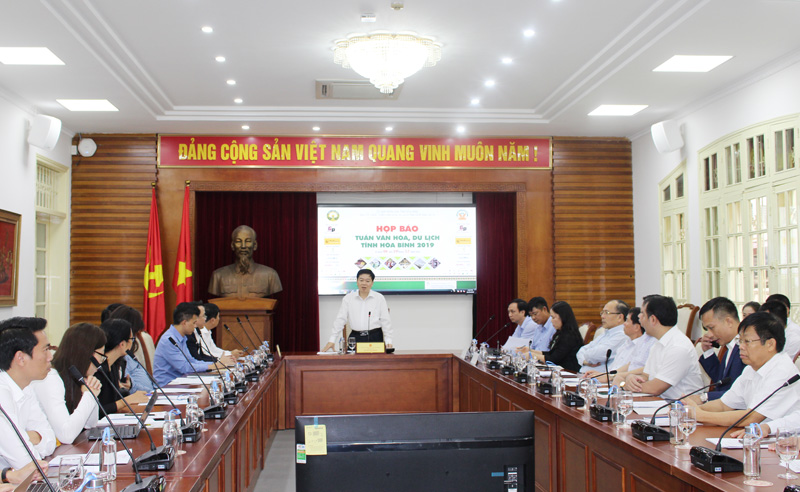
HBO) – The Hoa Binh Culture – Tourism Week will take place on December 6-10 to honour local culture value, people and land while creating opportunities for the province to popularise its economic and tourism development potential.
The information was heard at a press conference in Hanoi
on November 25, chaired by Vice Chairman of the provincial People’s Committee
Nguyen Van Chuong, who is also head of the organising board for the culture –
tourism week.
 Vice Chairman of the provincial
People’s Committee Nguyen Van Chuong, head of the organising board for the
culture – tourism week, speaks at the press conference.
Vice Chairman of the provincial
People’s Committee Nguyen Van Chuong, head of the organising board for the
culture – tourism week, speaks at the press conference.
A multitude of activities will be held during the event, including an opening
ceremony, the "Hoa Binh – land & people” art performance, an exhibition and
performance of outstanding intangible heritages in the locality, the Muong
Beauty contest’s final round, a tourism development conference, and a closing
ceremony.
Most of the questions raised by reporters at the press conference were about
Hoa Binh province’s tourism strengths and revenue, process to set up dossier on
Mo Muong for UNESCO’s recognition as a piece of the Intangible Cultural
Heritage of Humanity, upcoming culture-tourism weeks, and measures to prevent ripe-off
as well as ensure food safety and hygiene during the culture-tourism week,
among others.
Chuong said that the organising board is making meticulous preparation for the
event. The province will pay due heed to ensure social order and food safety
and hygiene during the week.
He expressed his hope that press agencies will attend and cover the
culture-tourism week so that the local people and land will be nudged closer to
domestic and international friends.
For further information about the event’s activities, reporters can contact the
provincial Department of Information and Communications, he added./.
Spanning thousands of hectares and winding gracefully along mountain slopes, hillsides, and riverbanks, the terraced rice fields of Lac Son District present a stunning and captivating beauty. This region, renowned for its remarkable terraced landscapes, is also the centre of Hoa Binh Culture known for numerous archaeological sites.
The life of Mong people in Hang Kia and Pa Co communes of Mai Chau district has improved much thanks to tourism development.
The man-made Hoa Binh Lake, with a water surface area of approximately 9,000 hectares and a capacity of 9.45 billion cubic meters, stretches over 200 kilometers from Hoa Binh to Son La provinces. With the goal of developing into a national tourism area, the Hoa Binh Lake tourism area is expected to not only become the largest tourism centre in the province but also one of the 12 key tourist destinations in the northern midland and mountainous region of Vietnam.
Da Bia hamlet, now Duc Phong, in Tien Phong commune, Da Bac district, was once almost isolated from the outside as the only way to the hamlet was to get a boat ride across the Hoa Binh reservoir. However, as its tourism potential has been unleashed, the hamlet has established itself as one of the most attractive destinations on the tourism map. It has even received the ASEAN Community-Based Tourism Awards in 2019.
In the first 9 months of 2024, Mai Chau district, Hoa Binh province welcomed over 684 thousand visitors to visit and relax. In which, over 516 thousand domestic visitors and more than 168 thousand international visitors. Total revenue from tourism is estimated at over 821 billion VND.
Da Bac district, bestowed with stunning landscapes, is developing ecological and resort tourism offerings. Several tourist sites, put into operation this year, has attracted throngs of high-spending and young domestic visitors.



 Vice Chairman of the provincial
People’s Committee Nguyen Van Chuong, head of the organising board for the
culture – tourism week, speaks at the press conference.
Vice Chairman of the provincial
People’s Committee Nguyen Van Chuong, head of the organising board for the
culture – tourism week, speaks at the press conference.